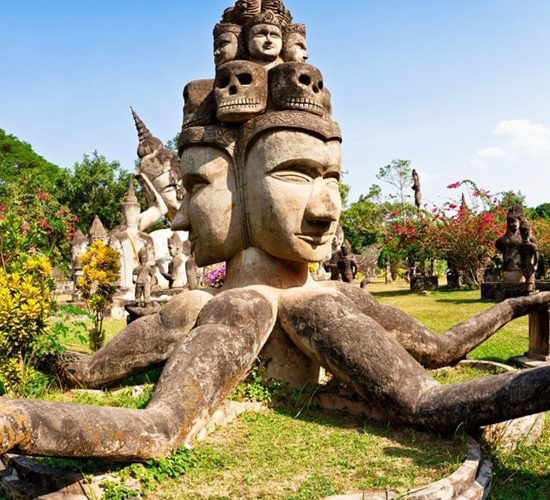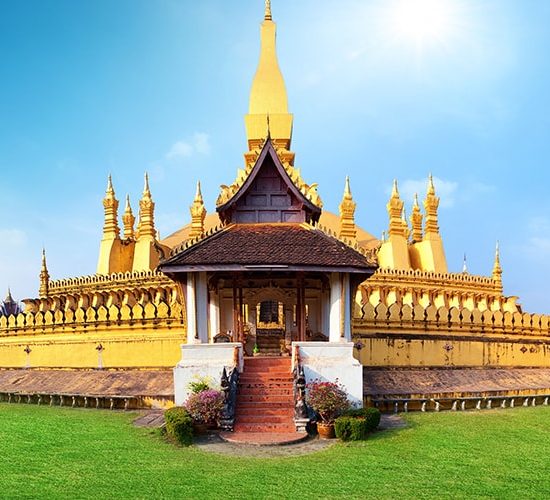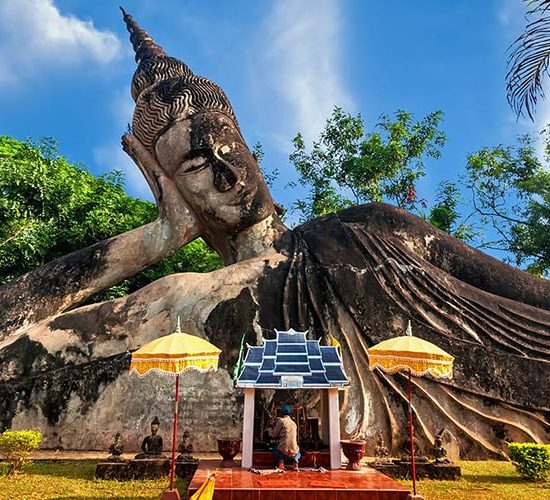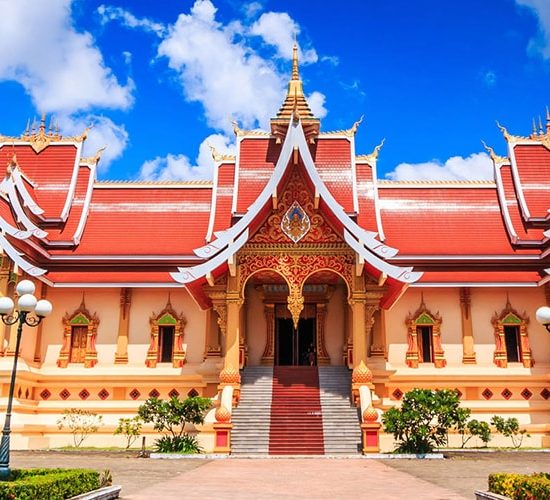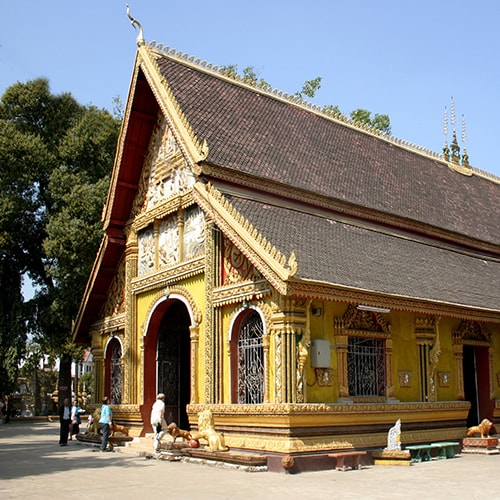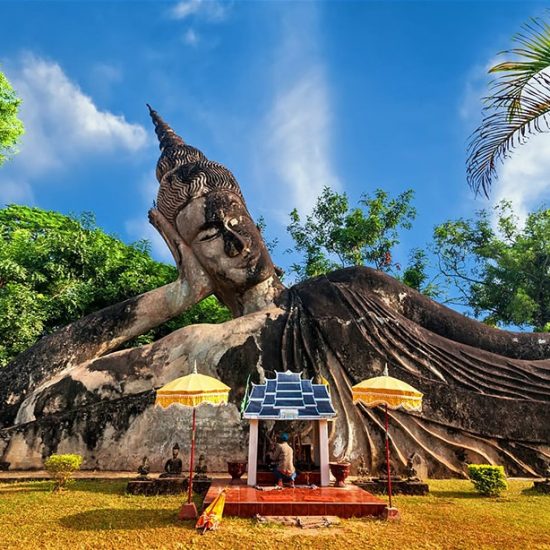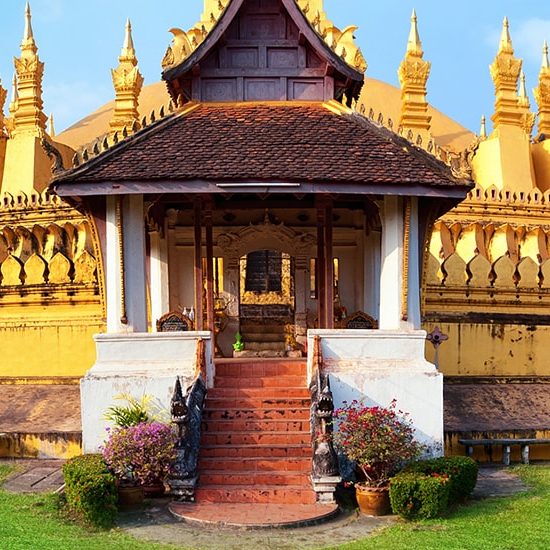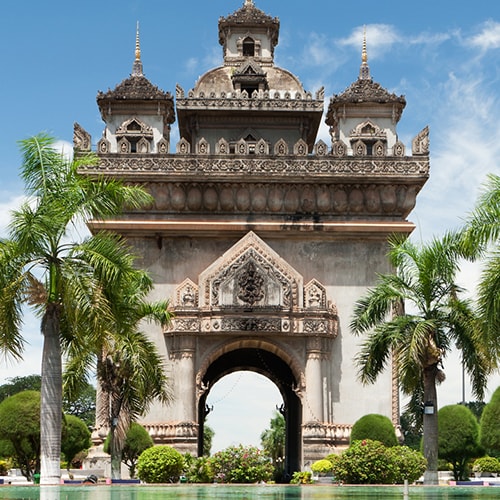Laos is a pristine and peaceful country, which attracts millions of tourists around the world to Luang Prabang with splendid temples, magnificent royal palace museums, unique jungle fields, Vientiane Buddha Garden. With special cultural features, temples with special architecture, delicious food suitable for Vietnamese taste. Laos is a destination many visitors in the world choose during their journey of discovery.
The cuture of Laos is characterized by many factors to includ the wonderful cuisine of Laos. With grilled ingredients from raw materials, wild like grilled chicken, grilled spring fish, wild boar, deer … and dishes. The taste of pungent influences to Thailand and mixed with Laos beer that it is very attractive to visitors.
When traveling to Laos, visitors will feel close, happy as their own home by the gentle, friendly, hospitable Lao. Laos tourism is not only unique, attractive by the traditional festival festival Bunpimay (Lao New Year), Tet Hmong but also by the festival takes place regularly.
Vientiane is the capital of Laos and an Asian capital – is it hard to believe? There’s a timeless quality to rural life, where stilt houses and paddy fields look like they are straight out of a movie set.
Table of Contents
1. On the ground
1.1 Sights
The Legend of Wat Si Muang
Legend has it that a group of sages selected the site for Wat Si Muang in 1563, when King Setthathirat moved his capital to Vientiane. Once the spot was chosen, a large hole was dug to receive the heavy stone pillar (probably taken from an ancient Khmer site nearby) that would become the lák méuang (city pillar). When the pillar arrived it was suspended over the hole with ropes. Drums and gongs were sounded to summon the townspeople to the area and everyone waited for a volunteer to jump into the hole as a sacrifice to the spirit.
Depending on who’s relating it, the legend has several conclusions. What is common to all of them is that a pregnant woman named Sao Si leaped in and the ropes were released, killing her and in the process establishing the town guardianship. Variations include her leaping in upon a horse, and/or with a diminutive monk.
However, Lao scholars think that if there is any truth to this story it is likely to have occurred much earlier than Setthathirat’s time, in the pre-Buddhist Mon or Khmer periods when human sacrifice was ritually practised…and that Sao Si’s legendary leap might not have been her choice at all.
Viewing Pha That Luang
Each level of Pha That Luang has different architectural features in which Buddhist doctrine is encoded; visitors are supposed to contemplate the meaning of these features as they walk around. The first level is an approximately square base measuring 68m by 69m that supports 323 sĕe máh (ordination stones). It represents the material world, and also features four arched hŏr wái (prayer halls), one on each side, with short stairways leading to them and beyond to the second level.
The second level is 48m by 48m and is surrounded by 120 lotus petals. There are 288 sĕe máh on this level, as well as 30 small stupas symbolising the 30 Buddhist perfections (báhlamée săhm-síp tat), beginning with alms-giving and ending with equanimity.
Arched gates again lead to the next level, a 30m by 30m square. The tall central stupa, which has a brick core that has been stuccoed over, is supported here by a bowl-shaped base reminiscent of India’s first Buddhist stupa at Sanchi. At the top of this mound the superstructure, surrounded by lotus petals, begins.
The curvilinear, four-sided spire resembles an elongated lotus bud and is said to symbolise the growth of a lotus from a seed in a muddy lake bottom to a bloom over the lake’s surface, a metaphor for human advancement from ignorance to enlightenment in Buddhism. The entire tâht was regilded in 1995 to celebrate the 20th anniversary of the Lao People’s Democratic Republic (PDR), and is crowned by a stylised banana flower and parasol. From ground to pinnacle, Pha That Luang is 45m tall.
Around Vientiane
There are several places worth seeing that are an easy trip from Vientiane; some make good day trips while others could detain you for much longer. Popular places include the jungle and homestays of Phu Khao Khuay NPA and the islands and bays of Ang Nam Ngum.
1.2 Activities
Popular activities in the city centre include enjoying a rub down in a spa and some cultural experiences with local hosts via the Backstreet Academy.
Swimming
There are several places in Vientiane where you can work on your stroke or simply take a cooling dip. You could try Sengdara Fitness, where a day pass costs 90,000K, including the pool. Several hotels welcome non-guests, including the beautiful Settha Palace Hotel, with its decadent pool and surrounding bar.
Beyond Vientiane City Centre
There are several activities located beyond the Vientiane city centre that can be combined together in a rewarding day trip. If planning a visit to Xieng Khuan (Buddha Park), then include stops at the Lao Disabled Women’s Development Centre and the Sinouk Coffee Pavilion, both located along the way. This can be done as a long bicycle ride, an easy motorbike trip or by public bus using the number 14 from Talat Sao Bus Station.
1.3 Sleeping
Vientiane is bursting with a wide range of accommodation, from cheap backpacker digs to beautiful boutique hotels and huge monolithic corporate hotels. Budget-wise, for shoestringers it’s easy to stretch your cash and hole up in a dorm for a few dollars, while you can pay hundreds of dollars a night in a top-end hotel. In the middle of these two extremes are some clean, intimate guesthouses for around $US20 per night (for a double room).
Apartments
If you’re going to be here for a while check out th luxury apartment complexes Somerset Vientiane and French-run Khunta Residence. Monthly rates start from US$1300 for a studio and US$1700 for a one-bedroom apartment.
Many of Vientiane’s small business hotels, such as City Inn and Phasouk Residence, also operate equally well as serviced apartments for those with generous housing allowances.
1.4 Eating
For such a small capital city, Vientiane boasts a range of culinary options and is an exceptional spot for fine dining on a budget.
Global Cuisine
The city has a wide range of global cuisine, including everything from falafel at an authentic Turkish restaurant to upscale Japanese and Korean barbecue. The streets that radiate off Th Setthathirath are vivid with smells and steam as old-school restaurants serve up fine Italian and French fare in the choicest of surroundings.
Lao food has in recent years enjoyed a real contemporary makeover with well-executed traditional dishes given a modern twist in 21st-century-style restaurants. If it’s comfort food you seek, look no further than the bakeries left by the French footprint, for the city is famous for its fresh-baked baguettes and crispy croissants, with full-bodied coffee that could make the Seine glow green with envy.
For all its Gallic refinement Vientiane is equally informal; cheap food on the hop can be grabbed from street vendors dotted around the old quarter, and the impromptu braziers that fire up grilled chicken and Mekong fish on skewers. And don’t miss the chance to wander through the redolent witch’s broth that is Chinatown on Th Hengboun.
Oodles of Noodles
Noodles of all kinds are popular in Laos, and Vientiane has the country’s greatest variety. The most popular noodle of all is undoubtedly fĕr, the local version of Vietnamese pho, served with beef or pork and accompanied, Lao-style, by a huge plate of fresh herbs and vegetables and a ridiculous amount of condiments. Also popular are kòw Ъûn, the thin rice noodles known as kànǒm jeen in Thailand, taken in Laos with a spicy curry-like broth or sometimes in a clear pork broth (kòw Ъûn nâm jąaou). There’s also kòw Ъęeak sèn, thick rice- and tapioca-flour noodles served in a slightly viscous broth with crispy deep-fried pork belly or chicken.
Other popular noodles include mii (traditional Chinese egg noodle), particularly prevalent in the unofficial Chinatown area bounded by Th Hengboun, Th Chao Anou, Th Khounboulom and the western end of Th Samsènethai, and bǎn kǔan (Lao for bánh cuôn), a freshly steamed rice noodle filled with minced pork, mushrooms and carrots, a Vietnamese speciality that is popular in Laos. Look for it in the mornings near the intersection of Th Chao Anou and Th Hengboun.
1.5 Drinking and nightlife
Vientiane is no longer the illicit pleasure palace it once was. Beerlao has replaced opium as the drug of choice and brothels are strictly prohibited, though predatory ladyboys can still be found lurking like noisy vampires on Th Setthathirath come nightfall.
Most bars close by midnight, apart from a few late-night stragglers. Karaoke is popular, as are live-music performances.
Best Lists
- Drinking & Nightlife
- Bor Pen Yang
- CCC Bar
- Chokdee Cafe
- Khop Chai Deu
- Jazzy Brick
1.6 Entertainment
Like everything else, Vientiane’s entertainment scene is picking up as money and politics allows, though the range remains fairly limited. By law, entertainment venues must close by 11.30pm, though most push it to about midnight.
Traditional Music & Dancing
Six types of traditional Lao dance can be seen nightly from 7.30pm to 11pm in the Lane Xang Hotel. The Lao National Culture Hall also hosts similar performances on occasions, but with no publicly available schedule of events you’ll need to keep a close eye on the Vientiane Times for announcements.
Cinema
Lao cinemas died out in the video-shop tidal wave of the 1990s, but there has been something of a comeback with the advent of big multiplex cinemas in the new shopping malls that are popping up around town.
1.7 Shopping
Just about anything made in Laos is available for purchase in Vientiane, including hill-tribe crafts, jewellery, traditional textiles and carvings. The main shopping area in town is along Th Setthathirath and the streets radiating from it.
Handicrafts, Antiques & Art
Several shops along Th Samsènethai, Th Pangkham and Th Setthathirath sell Lao and Thai tribal and hill-tribe crafts. The Lao goods are increasingly complemented by products from Vietnam and Thailand, such as lacquer work and Buddha images. Textile and clothing places often also carry handicrafts and antiques.
Textiles & Clothing
Downtown Vientiane is littered with stores selling textiles. Th Nokèokoummane is the epicentre, but the city’s main market, Talat Sao, is also a good place to buy fabrics. You’ll find antiques as well as modern fabrics, plus utilitarian items such as shoulder bags (some artfully constructed around squares of antique fabric), cushions and pillows.
To see Lao weaving in action, seek out the weaving district of Ban Nong Buathong, northeast of the town centre in Muang Chanthabuli. About 20 families (many originally from Sam Neua in Hua Phan Province) live and work here, including a couple of households that sell textiles directly to the public.
1.8 Orientation
Vientiane curves along the Mekong River following a meandering northwest–southeast axis, with the central district of Muang Chanthabuli at the centre of the bend. Most of the government offices, hotels, restaurants and historic temples are located in Chanthabuli, near the river. Some old French colonial buildings and Vietnamese-Chinese shophouses remain, set alongside newer structures built according to the rather boxy social realist school of architecture.
Wattay International Airport is around 4km northwest of the centre. The Northern Bus Station, where long-distance services to points north begin and end, is about 2km northwest of the airport. The Southern Bus Station deals with most services heading south and is 9km northeast of the centre on Rte 13. The border with Thailand at the Thai-Lao Friendship Bridge is 19km southeast of the city.
Street signs are limited to major roads and the central, more touristy part of town. Where they do exist, the English and French designations vary (eg route, rue, road and avenue) but the Lao script always reads Thanon (Th). Therefore, when asking directions it’s always best to just use Thanon.
The parallel Th Setthathirath (which is home to several famous temples) and Th Samsènethai are the main streets in central Vientiane. Heading northwest they both eventually lead to Th Luang Prabang and Rte 13 north. In the other direction they run perpendicular to and eventually cross Th Lan Xang, a major boulevard leading from the presidential palace past Talat Sao (Morning Market) to Patuxai (Victory Gate) and, after turning into Th Phon Kheng, to Rte 13 south and the Southern Bus Station.
The meuang of Vientiane are broken up into bâan (Ban), which are neighbourhoods or villages associated with local wats. Wattay International Airport, for example, is in Ban Wat Tai, the area in which Wat Tai is located.
2. Organize your time
2.1 Itineraries
Two Days
Start with a coffee and croissant at Le Banneton before embarking on the Monument to Mekong cycling tour, taking you through most of Vientiane’s main sights, including Wat Si Saket, Haw Pha Kaeo and Talat Sao. Top off your day with riverside cocktails at Spirit House. On day two consider getting some motorised wheels and leaving the city centre to visit the concrete Buddhas and Hindu deities at Xieng Khuan. On the way back stop at Pha That Luang for great afternoon photos. Enjoy a fine French dinner at Le Silapa.
Four Days
Depending on what time you crawl out of bed on day three, make PVO your lunch destination. It’s then a short walk to the COPE Visitor Centre, where you could easily spend a couple hours checking out the excellent exhibits and powerful documentaries. After a light Lao dinner at Khambang Lao Food Restaurant, head to nearby Herbal Sauna for a healthy Lao-style sweat. Rehydrate with draught Beerlao at Bor Pen Yang.
Day four can be spent at a Lao cooking course at Villa Lao, handicraft and textile shopping along Thanon Nokèokoummane, rummaging for communist wristwatches and glass Buddhas at Indochina Handicrafts, or sniffing and waxing lyrical about the handmade soaps and oils at T’Shop Lai Gallery.
2.2 When to go and weather
Nov–Feb A great time to visit, with the magical Bun Pha That Luang (Full Moon Festival) in November.
Mar–May Temperatures and humidity levels climbs, but hotel prices fall.
Jun–Nov The monsoon brings fresh air and river festivals like Bun Awk Phansa and Bun Nam.
3. Planning tools
3.1 Vientiane is known for
Buddhist Sites
Vientiane is home to some of the most iconic temples and Buddhist sites in the country.
Pha That Luang The golden stupa of Vientiane.
Wat Si Saket The oldest wat in the capital.
Haw Pha Kaeo A museum of Buddhist artefacts.
Wat Si Muang Home to the historic pillar of the city.
Xieng Khuan Other-worldly religious sculptures at ‘Buddha Park’.
Textiles & Silks
Laos is famous for its textiles and much of the most spectacular silk makes its way to the capital.
Carol Cassidy Lao Textiles Home to arguably the finest private collection in Vientiane.
Houey Hong Vocational Training Center for Women Dying to learn about weaving? This place has courses and runs the True Colour boutique.
Lao Textile Museum Private collection of a renowned silk collector that also owns the Kanchana Boutique.
Saoban Hand-woven silk textiles (at affordable prices) from 14 artisan communities across Laos.
Talat Sao The Morning Market was the original silk emporium long before the boutiques came to town.
Cafe Culture
The French left their mark on the city with golden croissants and barista-brewed coffee.
Bakery by Boris Sleek new cafe with the city’s most sumptuous pastries.
Le Trio Renowned coffee roaster and wholesaler.
Naked Espresso Home-roasted Lao coffee and imported gourmet beans.
Once Upon a Time Fairytale-themed coffee house run by award-winning barista.
Sinouk Coffee Pavilion Get a buzz from the regular cupping sessions offered at this shrine to coffee.
3.2 Money and costs
Currency
Lao kip (K)
Daily Costs
Budget: Less than US$30
- Dorm bed: US$5–10
- Local meals and street eats: US$2–4
- Bicycle hire: US$1.50–2.50 per day
Midrange: US$30–US$100
- Air-con hotel room: US$15–50
- Decent local restaurant meal: US$5–10
- Scooter hire: US$10 per day
Top End: More than US$100
- Boutique hotel or resort: US$50–500
- Gastronomic meal with drinks: US$15–50
- Guided tour with transport: US$50–75
Bargaining in most places in Laos is not nearly as tough as in other parts of Southeast Asia. Lao-style bargaining is generally a friendly transaction where two people try to agree on a price that is fair to both of them. Good bargaining, which takes practice, is one way to cut costs.More Information
Most things bought in a market can be bargained for, but in shops prices are mostly fixed. The first rule to bargaining is to have a general idea of the price. Ask around at a few vendors to get a ballpark figure. Once you’re ready to buy, it’s generally a good strategy to start at 50% of the asking price and work up from there. In general, keeping a friendly, flexible demeanour throughout the transaction will almost always work in your favour. Don’t get angry or upset over a few thousand kip. The locals, who invariably have less money than foreign visitors, never do this.
3.3 Travel with children
Small by the standards of Asian megacities, Vientiane is not such a daunting prospect for families. Many midrange hotels now have swimming pools and there is even the Ocean Park water park in town. Vientiane’s sights are not particularly noteworthy for children, but they should appreciate the surreal sculptures of Xieng Khuan (Buddha Park) and clambering around the larger monuments.
3.4 Arriving in destination
From the airport, taxis to the centre cost US$7 and minivans are available for US$8. Only official taxis can pick up at the airport.
If you’re on a budget and don’t have a lot of luggage, simply walk 500m to the airport gate and cross Th Souphanouvong and hail a shared jumbo (20,000K per person). Prices on shared transport will rise if you’re going further than the centre.
Buses 30 and 49 run past the airport (4000K) at least once per hour between 6am and 5.30pm en route to Talat Sao Bus Station in the city centre.
3.5 Entry and exit formalities
Visas
Getting an extension on a tourist visa is easy. Go to the Immigration Office, in the Ministry of Public Security building opposite Talat Sao, fill out a form, supply your passport, a photo and pay US$2 per day for the extra time you want. The whole process can be completed in one hour.
3.6 Planning tips
Resource
Ecotourism Laos (www.ecotourismlaos.com) Information about the Lao environs, focusing on trekking and other ecotourism activities.
Hobo Maps (http://hobomaps.com) Up-to-date maps and transportation details, mostly regarding northern Laos.
Lao National Tourism Administration (www.tourismlaos.org) Mostly up-to-date travel information from the government.
RFA (Radio Free Asia; www.rfa.org/english/news/laos) Unbiased, censorship-free news on Laos from Asia-based journalists.
4. Practical information
4.1 Getting around
Bicycle
Cycling is a cheap, easy and recommended way of getting around mostly flat Vientiane. Loads of guesthouses and several shops hire out bikes for 10,000K to 20,000K per day. Mountain bikes are available but are more expensive at 30,000K to 40,000K; try Lao Bike.
Bus
There is a city bus system, but it’s oriented more towards the distant suburbs than the central Chanthabuli district. Most buses leave from Talat Sao Bus Station, which is currently undergoing a massive renovation. The number 14 Tha Deua bus to the Thai–Lao Friendship Bridge and Xieng Khuan (Buddha Park) runs every 20 minutes from 5.30am to 6pm and costs 6000K. Buses 30 and 49 run past the airport (4000K) regularly. Bus number 8 runs to the Northern Bus Station (5000K) and number 29 to the Southern Bus Station (3000K).
Car & Motorcycle
There are several international car-hire companies with representation in Vientiane, including Avis-Budget and Sixt. Keep in mind that, while a basic sedan will get you around the city, you’ll need a sturdy 4WD for trips further afield.
Scooters are a popular means of getting around Vientiane and can be hired throughout the centre of town. Recommended hire places include the following:
Motorbike Touring from Vientiane
Motorbike activities have been growing in popularity for several years now. It’s now possible to travel on sturdy, well-maintained motocross bikes, connected by Laos’ competent mobile-phone service for backup with base, and handheld GPS devices to always keep you on track. And with drop-off and luggage-forwarding facilities to your destination available, you’re now able to tackle a slice of your holiday on two wheels (an alternative to duking it out on soggy, overcrowded buses). Rent by the week and take in the north via the mountains of Vang Vieng, continuing on to Luang Prabang and the rest of the north before leaving your bike in Luang Prabang. Or head south to explore the karst limestone mountains around Tha Khaek and eventually leave the motorbike in Pakse.
Recommended operators that hire dirt bikes or touring bikes and offer pick-up services at the end of your trip:
Drivenbyadventure Offers the most professionally maintained dirt bikes in Laos, including Honda CRF250s (US$38 per day), Honda XR400s (US$50) and KTM XCW450s (US$95).
Fuark Motorcycle Hire A leading locally owned and operated motorbike-hire place that offers a range of well-maintained dirt bikes (from US$30 per day) and drop-offs at key cities around the country.
Drivenbyadventure owner Don Duvall also masquerades as mysteriously monikered Midnight Mapper, spending the last 10 years tirelessly mapping Laos, and you can buy his satellite map off his website and plug it into your GPS gadget. It costs US$50, and he mails you the SIM card, or can rent you a Garmin handheld GPS device for US$7 per day and plug in your coordinates so you never get lost.
Jumbo & Tuk-Tuk
Drivers of jumbos and tuk-tuks will take passengers on journeys as short as 500m or as far as 20km. Understanding the various types of tuk-tuk is important if you don’t want to be overcharged (and can save you arguments in addition to money). Tourist tuk-tuks are the most expensive, while share jumbos that run regular routes around town (eg Th Luang Prabang to Th Setthathirath or Th Lan Xang to That Luang) are much cheaper, usually less than 10,000K per person.
A Beginner’s Guide to Tuk-Tuks & Jumbos
Tourist Tuk-tuks You’ll find these loitering in queues outside popular tourist spots, such as at Nam Phu. In theory, chartering a tuk-tuk should be no more than 20,000K for distances of 1km or so, but these guys will usually show you a laminated card with a list of fares that are at least double what a Lao person would pay. Bargaining is essentially fruitless because there is an agreement within the queue that tuk-tuks won’t budge from the agreed tariff.
Wandering Tuk-tuks These tuk-tuks will pick you up anywhere and negotiate a fare to anywhere. Prices are lower than tourist tuk-tuks and rise as you head further away from main roads. If you’re going somewhere within the centre of town, you can probably get away with handing the driver 15,000K to 20,000K and telling him where you want to go.
Fixed-route Share Jumbos The cheapest tuk-tuks are more like buses, starting at tuk-tuk stations and operating along set routes for fixed fares. The biggest station is near Talat Sao and one very useful route runs to the Friendship Bridge (5000K, compared with about 200B for a charter). Just turn up and tell them where you want to go.
Taxi
Car taxis of varying shapes, sizes and vintages can often be found stationed in front of the larger hotels or at the airport. Bargaining is the general rule, although there are a couple of meter-taxi companies operating now, including the following:
Meter Taxi Service Drivers from this company often wait for fares on Th Pangkham, just across from the Day Inn Hotel.
Taxi Vientiane Capital Lao Group Another
4.2 Flights and getting there
Air
Laos has air connections with regional countries including Thailand, Vietnam, Cambodia, Malaysia, China and South Korea. The most convenient international gateway to Laos is Bangkok and there are plenty of flights to the Thai capital. If heading to Laos for a shorter holiday, it is cheaper to take an indirect flight to Bangkok with a stop on the way. Once in Bangkok, there are planes, trains and buses heading to Laos.
Airports & Airlines
There are four international airports in Laos: Wattay International Airport in Vientiane, Luang Prabang International Airport, Savannakhet International Airport and Pakse International Airport.
Air Asia (www.airasia.com) Flights from Vientiane to Bangkok daily and Kuala Lumpur three times per week, plus Luang Prabang to Bangkok and Kuala Lumpur.
Bangkok Airways (www.bangkokair.com) Daily flights between Bangkok and Vientiane and Luang Prabang.
China Eastern Airlines (www.ce-air.com) Flies daily to Kunming and Nanning from Vientiane, plus Luang Prabang to Kunming three times per week.
Jin Air (www.jinair.com) Daily connections between Vientiane and Seoul.
Lao Airlines (www.laoairlines.com) National carrier. The extensive international flight network includes Vientiane to Bangkok, Busan, Changsha, Changzhou, Guangzhou, Hanoi, Kunming and Seoul; Luang Prabang to Bangkok, Chengdu, Chiang Mai, Hanoi and Jinghong; Pakse to Ho Chi Minh City and Siem Reap; and Savannakhet to Bangkok.
Thai Airways (www.thaiairways.com) Vientiane to Bangkok daily.
Vietnam Airlines (www.vietnamairlines.com) Connects Vientiane with Hanoi and Phnom Penh, plus Luang Prabang with Hanoi and Siem Reap.
Departure Tax
There is a departure tax of US$10 on all international flights, but it is included in the ticket price at the time of purchase.
Land
Laos shares land and/or river borders with Thailand, Myanmar (Burma), Cambodia, China and Vietnam. Border-crossing details change regularly, so ask around and check the Thorn Tree (lonelyplanet.com/thorntree) before setting off.
It’s possible to bring a car or motorcycle into Laos from Cambodia and Thailand with the right paperwork and Lao customs don’t object to visitors bringing bicycles into the country, but it is not currently possible from Vietnam, China or Myanmar.
Cambodia
There are daily buses and minibuses connecting Pakse with Stung Treng (four hours), Kratie (six hours) and Phnom Penh (11 hours). These also stop at Ban Nakasang and Ban Hat Xai in both directions for travellers planning to relax in Si Phan Don. It’s best to take one of these through-buses, as it’s pretty tough to arrange transport at the Non Nok Khiene (Laos)/Trapaeng Kriel (Cambodia) border.
China
Handy through-buses link major towns in Yunnan to northern Laos. Routes include Luang Namtha–Jinghong (six hours), Udomxai–Mengla (five hours) and Kunming–Luang Prabang (around 24 hours on a Chinese sleeper bus). It’s also perfectly feasible to make the journey in hops via Boten, the only China–Lao border crossing currently open to foreigners. From Móhān on the Chinese side it’s around a two-hour minibus ride to Mengla, the nearest large town.
Myanmar
The first Lao-Myanmar Friendship Bridge officially opened in May 2016 connecting Xieng Kok in Luang Namtha Province with Tachelik District in Shan State. However, border-demarcation disagreements have delayed it opening for international traffic. Check in Vientiane or Luang Namtha before setting off this way or play it safe and transit through Thailand, via Chiang Khong and Mae Sai, to the Burmese town of Tachilek.
Thailand
There are eight crossings to Thailand open to foreigners. Some involve taking a boat across the Mekong, or crossing the river on one of the Friendship Bridges.
Thailand to Vientiane
Through-buses run regularly between Vientiane and the Thai towns of Khon Kaen (four hours), Nakhon Ratchasima (seven hours), Nong Khai (1½ hours) and Udon Thani (2½ hours) via the Friendship Bridge. There are also several daily trains (www.railway.co.th/english) from Bangkok to Nong Khai (about 12 hours), as well as daily departures between Nong Khai and Vientiane’s Dongphasy Station. From Udon Thani there are budget flights to Bangkok and other domestic destinations in Thailand.
Thailand to Northern Laos
The majority of visitors are heading to or from Luang Prabang. There are three main options but no route allows you to make the trip in a single journey. The Chiang Rai–Huay Xai–Luang Prabang route is by far the most tourist-friendly and potentially the quickest route (around 24 hours using buses, or two days by bus-boat combination).
Travel this way is via Chiang Khong/Huay Xai. Departing from Chiang Rai on the first bus of the day it is possible to connect with the slowboat from Huay Xai to Luang Prabang, arriving the following evening. Or leave Chiang Rai at lunchtime and connect with the 5pm overnight bus (faster but not recommended when compared with the beautiful boat journey), arriving in Luang Prabang late next morning.
Sea
Laos is a landlocked country, so there is no access by sea
4.3 Health
Health issues and the quality of medical facilities vary enormously depending on where and how you travel in Laos. Travellers tend to worry about contracting infectious diseases when in the tropics, but infections are a rare cause of serious illness or death in travellers. Pre-existing medical conditions such as heart disease and accidental injury account for most of the life-threatening problems. Falling ill in some way, however, is relatively common. Fortunately, most common illnesses can either be prevented with common-sense behaviour or be treated easily with a well-stocked traveller’s medical kit.
4.4 Directory information
Accessible Travel
With its lack of paved roads or footpaths (sidewalks), Laos presents many physical obstacles for people with mobility impairments. Rarely do public buildings feature ramps or other access points for wheelchairs, nor do most hotels make efforts to provide access for the physically disabled, the few exceptions being at the top end in Vientiane and Luang Prabang. Most sights have no disabled access. Public transport is particularly crowded and difficult, even for the fully ambulatory.
For wheelchair users, any trip to Laos will require a good deal of advance planning.
Bargaining
Bargaining in most places in Laos is not nearly as tough as in other parts of Southeast Asia. Lao-style bargaining is generally a friendly transaction where two people try to agree on a price that is fair to both of them. Good bargaining, which takes practice, is one way to cut costs.
More Information
Most things bought in a market can be bargained for, but in shops prices are mostly fixed. The first rule to bargaining is to have a general idea of the price. Ask around at a few vendors to get a ballpark figure. Once you’re ready to buy, it’s generally a good strategy to start at 50% of the asking price and work up from there. In general, keeping a friendly, flexible demeanour throughout the transaction will almost always work in your favour. Don’t get angry or upset over a few thousand kip. The locals, who invariably have less money than foreign visitors, never do this.
Climate
The annual monsoon cycles that affect all of mainland Southeast Asia produce a dry and wet monsoon climate, with three basic seasons for most of Laos. The southwest monsoon arrives in Laos between May and July and lasts into November.
The monsoon is followed by a dry period (from November to May), beginning with lower relative temperatures and cool breezes created by Asia’s northeast monsoon (which bypasses most of Laos) and lasting until mid-February. Exceptions to this general pattern include Xieng Khuang, Hua Phan and Phongsali Provinces, which may receive rainfall coming from Vietnam and China during the months of April and May.
Temperatures also vary according to altitude. In the humid, low-lying Mekong River valley, temperatures range from 15°C to 38°C, while in the mountains of the far north they can drop to 0°C at night. Particularly cold years see snow falling in the mountains.
Dangers & Annoyances
Over the last couple of decades Laos has earned a reputation among visitors as a remarkably safe place to travel, with little crime reported and few of the scams often found in more touristed places such as Vietnam, Thailand and Cambodia. And while the vast majority of Laotians remain honest and welcoming, things aren’t quite as idyllic as they once were. The main change has been in the rise of petty crimes, such as theft and low-level scams, which are more annoying than dangerous.
Queues
The Lao people follow the usual Southeast Asian method of queuing for services, which is to say they don’t form a line at all but simply push en masse towards the counter or doorway. The system is ‘first seen, first served’. Learn to play the game the Lao way, by pushing your money, passport, letters or whatever to the front of the crowd as best you can. That said, it is nowhere near as chaotic as in some of the bigger neighboring countries.
Road & River Travel
Better roads, better vehicles and fewer insurgents mean road travel in Laos is quite safe, if not always comfortable. However, while the scarcity of traffic in Laos means there are far fewer accidents than in neighbouring countries, accidents are still the main risk for travellers.
As motorbikes become increasingly popular among travellers, the number of accidents is rising. Even more likely is the chance of earning yourself a Lao version of the ‘Thai tattoo’ – that scar on the calf caused by a burn from a hot exhaust pipe.
The speedboats that careen along the Mekong in northern Laos are as dangerous as they are fast. We recommend avoiding all speedboat travel unless absolutely necessary.
Armed Attacks
With the Hmong insurgency virtually finished, travel along Rtes 7 and 13, particularly in the vicinity of Phu Khoun and Kasi, is considered safe, although there was a deadly attack on a Chinese national in this area in early 2016. Ask around in Vientiane or Luang Prabang to make sure the situation is secure before travelling along Rte 7 to Phonsavan or Rte 13 between Vang Vieng and Luang Prabang. Rte 1 from Paksan to Phonsavan is still considered a risk due to occasional banditry.
Theft
While Lao people are generally trustworthy and theft is much less common than elsewhere in Southeast Asia, it has been on the rise in recent years. Most of the reports we’ve heard involve opportunistic acts that are fairly easily avoided.
Money or items going missing from rooms is becoming more common, particularly in rural bungalows, so don’t leave cash or other tempting belongings on show. When riding a crowded bus, watch the luggage and don’t keep money in loose trouser pockets. When riding a bicycle or motorcycle in Vientiane, don’t place anything of value in the basket, as thieving duos on motorbikes may ride by and snatch a bag.
Motorcycle theft is a growing problem. Always lock up your bike when out in the countryside or at night, and pay for parking whenever you can.
Unexploded Ordnance (UXO)
Large areas of eastern and southern Laos are contaminated by unexploded ordnance (UXO). According to surveys by the Lao National UXO Programme (UXO Lao) and other nongovernment UXO clearance organisations, the provinces of Salavan, Savannakhet and Xieng Khuang are the most severely affected provinces, followed by Champasak, Hua Phan, Khammuan, Luang Prabang, Attapeu and Sekong.
Statistically speaking, the UXO risk for the average foreign visitor is low, but travellers should exercise caution when considering off-road wilderness travel in the aforementioned provinces. Stick only to marked paths. And never touch an object that may be UXO, no matter how old and defunct it may appear.




